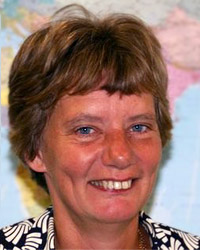


Joke Bouwstra is responsible for skin research at Leiden Academic Centre for Drug Research (LACDR). She received her Ph.D degree in 1985. In the same year she was appointed as Assistant Professor at the Centre for Bio-Pharmaceutical Sciences (renamed to LACDR). In 1988, she started in the field of transdermal and dermal drug delivery. In 2003, she was appointed as Full Professor. She has published more than 300 reviewed papers, more than 30 book chapters, and is co-inventor of 11 patents. She was chair of the Gordon Research Conference on Barrier Function of Mammalian Skin in 2003. Her main expertise is the barrier of healthy and diseased skin and the delivery of biologics into the skin. A key issue in her research is the lipid composition and organization as a result of inflammatory skin diseases. She combines findings obtained in clinical studies with results from in vitro systems, such as human skin equivalents and lipid membrane systems. Concerning the delivery of biologics, the main focus is the delivery of antigens by using various types of microneedles combined with nanoparticulate formulations into the skin aiming for an effective vaccination.
Skin Barrier
Bouwstra’s group has been carrying out pioneering work on the skin barrier for a number of years. The upper layer of the skin protects the body against excessive moisture loss from inside and against intruders from outside such as chemicals and bacteria. Lipids play a central role in this barrier function. Knowledge about the skin barrier is important in order to apply medication through the skin more effectively. This knowledge is also crucial to better understand and treat the diminished barrier function in diseased skin, and to make a correct diagnosis at an early stage.
Self-developed Model Systems
The Bouwstra group uses self-developed model systems in skin research. The information obtained is directly applied in clinical studies which measure the skin’s barrier function, the properties of lipids, and the disintegration of certain proteins.
Sensitive Techniques
As part of their research, Bouwstra and her fellow researchers from the Leiden Amsterdam Centre for Drug Research (LACDR) and Leiden University Medical Center (LUMC) developed new, sensitive techniques to analyse both the accumulation of lipids in the skin and the composition of these lipids. Only small samples of skin are needed, which can be taken from the skin surface with a tape especially developed for the purpose. The procedure is both painless and quick. The site where the sample has been taken can hardly be seen on the surface of the skin. The sample is then analysed using the techniques developed.
Vaccination
Another objective of the research in Bouwstra’s group is preventive vaccination through the skin using micro-needles and nanoparticles. This method is more effective than traditional injection with a needle. A further important consideration is that the method is painless. The latter is important for applying within the national vaccination programme for children. Bouwstra and her colleagues hope that not only preventive vaccination, but also therapeutic vaccination, for instance against cancer, can be carried out more effectively through the skin.
Eczema
Bouwstra’s research group collaborates closely with the Dermatology Department of the LUMC. Together they focus primarily on eczema, a skin condition that occurs frequently in children. In the industrialised world, 15% to 20% of children suffer from eczema, partially as a result of modern heating systems. It is important to identify and treat this disease at an early stage. The LACDR and the Dermatology Department also work on innovative techniques to grow new skin from isolated cells. By optimising growing conditions, the skin barrier of both healthy and diseased skin can be imitated as accurately as possible.